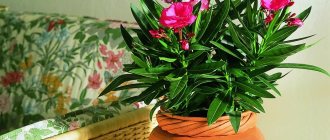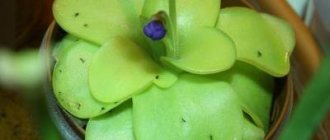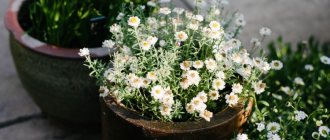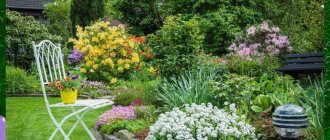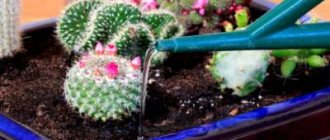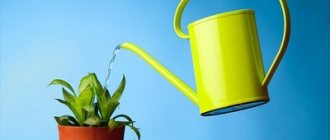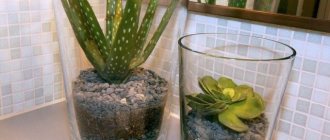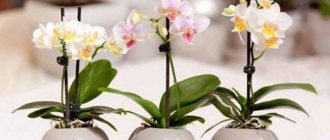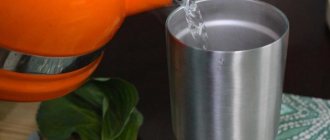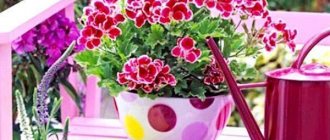Aquatic aquarium plants on the windowsill can look no less beautiful than ordinary ones. At the same time, such representatives of the flora can also add originality to the interior of the rooms. Caring for aquatic plants, of course, has some of its own characteristics. However, growing such beauty on a windowsill is still easier than, for example, the same capricious orchids.
Of course, the most spectacular aquatic plants are nymphs. With some skill, you can grow such flowers on a windowsill.
However, in the summer these beauties still bloom at home on the loggia, next to the geraniums. On the windowsill in the living room I grow simple aquarium plants.
Tulip
Remember that tulips need 12 to 16 weeks of “hibernation”, otherwise you will only get leaves and flowers will not be able to form. The bulbs can spend this time in the refrigerator. However, keep them away from apples. The gas released from the fruit is harmful to tulips.
After “wintering” the bulbs, take a glass vase, place washed stones or glass decorative beads on the bottom and pour water level into the “ground”. Place the bulbs on top of the glass beads so that the water just touches the base of the bulbs, pointy side up. Maintain water levels and provide plants with warmth and light. Forcing tulips can be timed to coincide with any holiday; to do this, you just need to count the correct number of weeks for stratification and plant growth.
How to make your own nutrient solution
Knop's nutrient solution has been used in hydroponics for a long time, even before the advent of ready-made fertilizer concentrates. They take soluble minerals that contain macroelements and some microelements necessary for plants.
Dry salts for preparing the solution are stored separately in tightly closed jars. Each substance is dissolved separately in a small amount of water. When preparing the Knop solution, add salts one at a time so that no precipitate appears. This fertilizer cannot be considered universal, since it contains calcium nitrate, and calcium is not suitable for all plants, there are no microelements. You can add microelements to the solution yourself.
Basil
A basil bush can be grown from a small shoot or cutting. To do this, place the shoot in a jar of water and place it in a well-lit place. In just 6-7 days the plant will take root. After which the cutting can be planted in the ground, but it can also be left in water; it will develop beautifully and produce new shoots.
Even though basil grows in water, its leaves also benefit from moisture, so mist it 2-3 times a week and change the water in the container daily. In just 2-3 weeks you will be able to add fresh leaves of the aromatic herb to salads, and in total such a plant will be able to supply greens to the table for 3-4 months. Other herbs can also be grown using landless methods.
Winter garden with pond
A conservatory with a water feature can be a simple structure for lily pads, as shown below, or a spectacular feature with a waterfall, lighting, a variety of aquatic life inside and a collection of indoor plants outside. The main requirements are a solid base and a completely waterproof inner surface. The tank must be deep enough to plant the selected plants. If you plan to grow water lilies, you will have to give up breeding fish and installing a fountain or waterfall.
The easiest way is to buy a rigid liner and cover the sides with wood panels or veneer. Brick or stone will give the pond a more substantial appearance. To improve their appearance, brick and block walls can be tiled. At this stage, you can install a filtration system to ensure clean water.
Fill the reservoir with tap water and leave for three days before planting. The minimum depth required will depend on the plants you plan to grow. Aim for about two-thirds of the surface to be covered with lily pads and/or floating plants to suppress green algae growth. Every five years the pond may need to be cleaned by pumping out the water. While this work is underway, keep the plants in buckets of water.
If you plan to install a fountain or waterfall, hire an electrician. And remember that an active baby can drown in water depths of only 10 cm.
Rigid form. Use a fiberglass pond. If surrounding walls will be built, choose a simple shape (square, rectangle, semicircle, etc.). Thinner polyethylene ponds may require wood framing for support. Usually the color chosen is black, but it depends on taste.
Flexible coating. Use butyl rubber film. For the pond, choose a simple shape. A thick wall is required that can withstand the pressure of the mass of water. Make sure the mortar is completely set before filling with water. After filling, fold the edges and corners of the film, wrap it over the edges and secure it.
No lining material. You can do without a liner if the brick or block wall is made on a concrete base. The inside can be plastered with cement to improve the appearance. This is optional, but applying two coats of pond paint inside is necessary. Follow the instructions on its packaging.
Bamboo
Select a container that is taller than the bamboo cuttings. Rinse it and the stones you plan to use thoroughly. Place the latter on the bottom, they should hold the bamboo.
Add non-chlorinated water to the jar so that 4-5 centimeters of the cuttings are in the water. Filtered or bottled water is suitable for growing bamboo. Regular tap water should be left standing for at least 24 hours. Place the vase in a bright place, but not in direct sunlight. Bamboo is quite suitable for artificial lighting.
Change the water at least once every two weeks, preferably weekly. Rinse the leaves and stems of your bamboo plant under warm running water once or twice a month to prevent or remove spider mites. Once a month it can be fed with organic fertilizer.
Tradescantia
Tradescantia leaves and flowers can be of different colors: from white to purple. The plant is very unpretentious. Thanks to this quality, Tradescantia is gaining popularity.
All this plant requires is proper lighting (it cannot be constantly in the shade or in the sun, you need to place it evenly here and there, otherwise the flower will die), a temperature from 12°C to 30°C.
If Tradescantia is grown in soil, then it is necessary to provide frequent watering, but under no circumstances should the soil be left very wet - the roots of the flower will rot. Also, special attention should be paid to air humidity - if there is insufficient humidity, the plant will get sick more often.
Indoor reeds
Isolepis drooping, or indoor reed, is a plant of the sedge family, whose homeland is swamps and other heavily moist areas. Therefore, it will not be difficult to grow it in a pot with water. Isolepis shoots first grow upward, then wander around, so it is better to take a tall, not too wide container.
When the indoor reed grows, a flowerpot with it will become a wonderful home decoration. The plant reproduces by seeds and division of the rhizome; to grow in water, you need to take a bush that is not too small; soft, settled water should cover the roots.
Do not place isolepis in bright sunlight; partial shade and humidity are the best conditions for its growth. Indoor reeds also benefit from monthly fertilizers that do not contain calcium.
Flowers for a bathroom without a window
It seems an incredible idea, but among indoor plants there are some that can really please owners in bathrooms that do not have windows. Among the most common:
- the same Decembrist,
- dieffenbachia,
- arrowroot,
- monstera,
- fern,
- ivy - the most common, with small foliage,
- fatsia,
- Usambara violets,
- ficus,
- chlorophytum,
- hoya,
- chrysanthemum,
- cyclamen, as well as plants of the aroid family.
Flowers purify the apartment and the air in it
Tall furniture will decorate additional places
The tiles will be able to retain the optimal amount of moisture in the bath atmosphere every day
Eichornia
Water hyacinth or eichornia is a beautiful and unpretentious plant. Water is all you need to grow. Eichornia is easy to grow in a garden pond and even on the surface of an aquarium. Flower growers did not ignore it either.
This plant loves wide, deep containers of water located in warm places with good lighting. Afraid of drafts. A special foam float ring will keep the plant afloat. In summer, under favorable conditions, it pleases with delicate lilac, orchid-like flowers.
To stimulate flowering, the water temperature is raised to 30 degrees. It is advisable to fertilize with complex fertilizers for aquarium plants or liquid fertilizers for indoor flowers.
Which aquarium plants to choose for the windowsill
A beautiful composition in a vase can be created using different aquarium greens. But you should choose only unpretentious aquatic plants for growing on the windowsill, which do not require a lot of space and complex care. It is believed that small vases may be suitable, for example:
- Riccia, Cladophora and Java moss;
- various kinds of ferns;
- hornwort and vallisneria;
- rotals.
Of course, you shouldn’t plant the vase too densely. It is best to first cover the bottom of such a container with aquarium soil or sea or river pebbles.
Tarragon
Dragon's wormwood (tarragon or tarragon) can be propagated by cuttings or by dividing the bush. Place the cutting in water, cutting off the lower part. When dividing the bush, wash the roots if there are any remaining soil on them.
Add a little liquid mineral fertilizer to the water. It will take no more than a week for the root system to form. Change the water once a week, but avoid chlorinated water; it is better to use settled water. If possible, use spring or well water; it contains dissolved minerals that are beneficial to plants. You can use any glass container, but you must remember that the sun is not good for the roots, so wrap the jar in paper to shade the roots.
Growing plants in water does not require complex manipulations and equipment; on the contrary, it simplifies obtaining results. Don't be afraid to experiment, it's interesting and suitable for family activities with children, or if there is no area for planting.
Hydroponic technology in home floriculture
Indoor flowers have different requirements for water and air conditions, which is due to the characteristics of the regions of origin of natural species. Although hydroponics for hobbyists is as simple as possible, it depends on the biology of houseplants. Some systems are not suitable for gardeners due to the high cost of equipment and lack of space for placement.
To create a hydroponic system at home you will need:
- Capacity - a waterproof reservoir for nutrient solution.
- Pot holder: lid with holes or special stands.
- Filler is a substrate that serves as a soil substitute.
- Hydroponic pot, permeable to water.
- Houseplants.
- Water.
- Water level indicator to optimize irrigation.
- Special fertilizers for hydroponics are a source of nutrients.
This list is variable. In some cases, you can refuse the substrate, in others you can do without holders.
Water cultivation
The deep water culture system, although complex in its scientific definition, is simple and effective in hydroponics for indoor plants. Prepare a nutrient solution and fill a vessel (reservoir) with it. An indoor flower in a mesh pot is placed in a special hole on the lid of this container. Or install a floating polystyrene foam plate in the tank with holes for plants. Or initially take a vessel with a narrow neck, in which the stems are conveniently fixed.
Recommendations:
- The liquid level should reach the roots until they sprout and enter the solution.
- You can then leave space between the liquid and the roots for aeration.
- You will need an air pump, like in an aquarium, to enrich the water with oxygen.
The disadvantages of water cultivation include the need to clean the container from sediment. If you do not leave an air gap between the roots and the solution, the liquid level will be constantly high. Therefore, root rot often develops.
Substrate use
Substrate culture is hydroponic cultivation with periodic wetting of bulk material with a nutrient solution: from below from a tray or from above (watering). Mineral, organic and synthetic materials are used. They hold the flower in the pot and transfer the fertilizer solution through the pores to the roots.
Types of substrates:
- mineral (expanded clay, river and sea pebbles, vermiculite, broken brick, pumice chips, perlite, granite gravel, coarse sand, glass wool);
- organic (coconut fiber, sawdust, peat, chopped straw, shavings, moss);
- synthetic (ion exchange resins, granulated polyethylene, polystyrene chips, plastic sponge).
When a pot with a substrate is immersed in a container with a solution, 3 zones appear. The top of the pot is dry. The middle zone is a substrate with voids filled with a nutrient solution and a root system. At the bottom there is water with liquid fertilizer.
A variation of the substrate method is wick water supply.
Pots with plants are placed in the holes on the lid of the reservoir with the nutrient solution. One end of the wick is placed in a nutrient liquid, the other is held to the roots in a pot with substrate.
Aeroponics
Aeroponics is one of the most complex and expensive methods. The roots grow strong and, accordingly, indoor flowers develop better in an environment saturated with small drops (mist or aerosol) of the nutrient solution. This hydroponics technology is called aeroponics and is used for growing indoor plants on an industrial scale.
The method does not require a substrate. Plant roots, located in a waterproof container, are periodically moistened with an aerosol of nutrients. The main advantage of aeroponics is the excellent supply of oxygen to the roots.
Features of placing flowers in the bathroom
For placement in a standard bathroom, plant compositions should be as compact as possible.
The vertical space of the room should be used as much as possible. A free wall can be occupied by a whole rack of flowerpots. Hanging hanging plant species are ideal for this. And by building a small shelf above the mirror, you can create an original green frame for it.
If there are free corners in the bathroom, then you can put large plants in them that grow in massive pots.
In a spacious bathroom, bushy plants with a lush “mane” will look good if they are placed on a chest of drawers, a low cabinet or on a shelf above the entrance.
It is recommended to place low-growing and most decorative plants with beautiful foliage in the foreground of the composition.
Designers also recommend actively using mirrors in the design, especially in small bathrooms. If you place pots of herbs opposite mirrors, this will visually increase the space.
Care Tips
- When selecting plants for the bathroom, do not forget that even the most moisture-loving people need fresh air. Therefore, to avoid rotting and fungal diseases, the room must have good ventilation. If the humid air in the bathroom stagnates, mold will inevitably appear, and the plants will be affected by powdery mildew, which is not easy to combat.
- Most green pets prefer a temperature of 20–22 degrees.
- When the large leaves of the plants become covered with dust, it is recommended to wipe them with a soft sponge, and give the plant itself a “bath day” - water it with warm water from the shower.
- Increased air humidity in the bathroom allows you to do without regular spraying, which moisture-loving indoor plants need.
- How plants will feel and how decorative they will look in such a room largely depends on where they are placed and the level of lighting.
